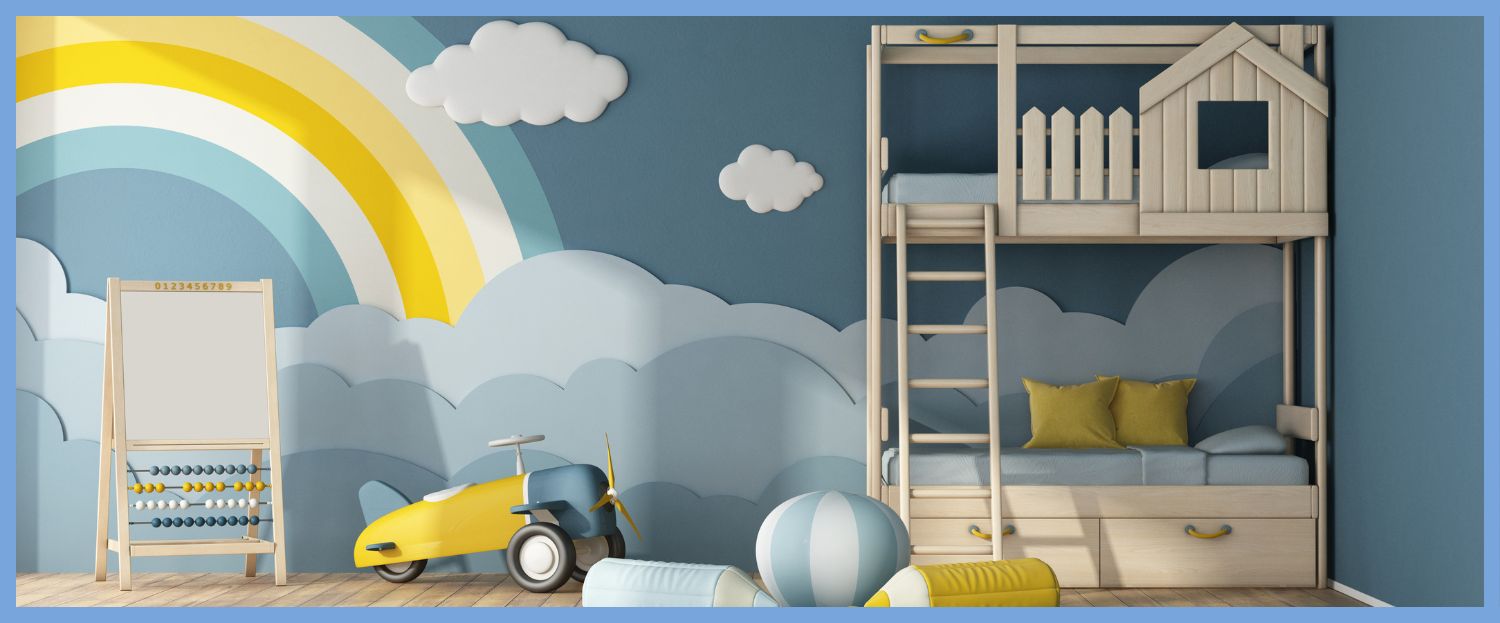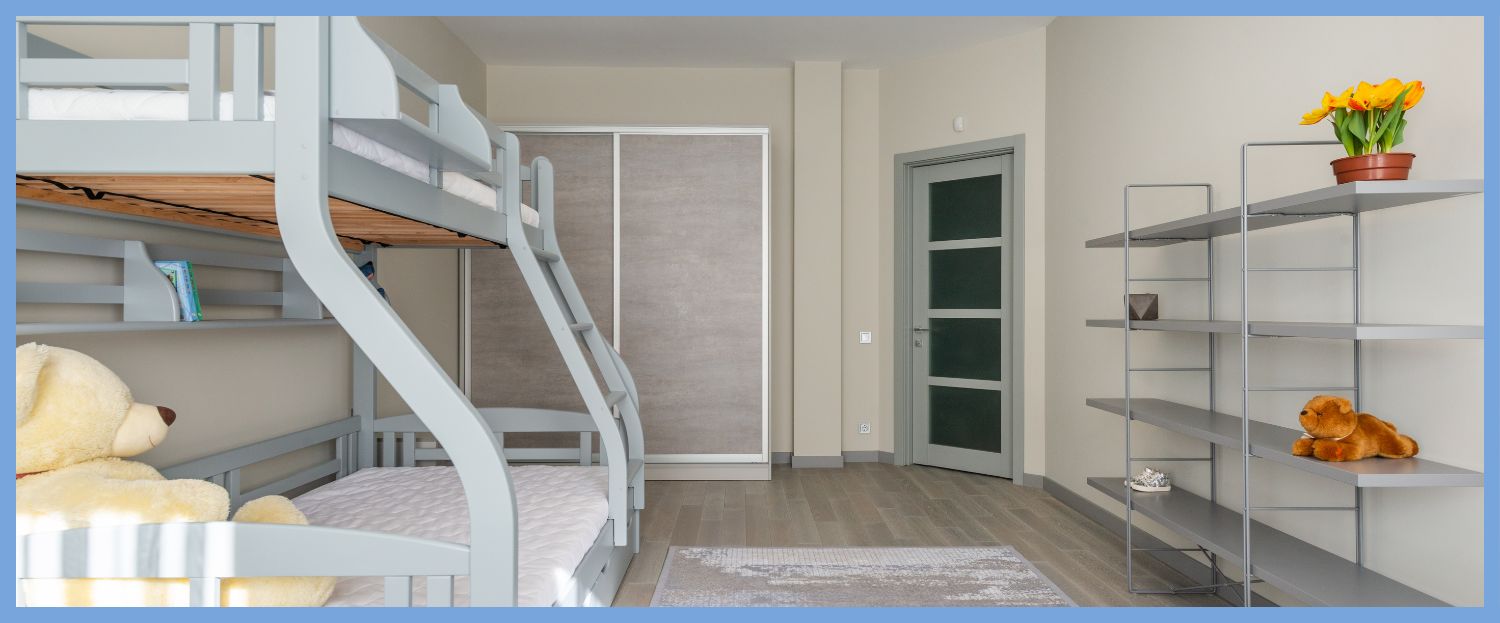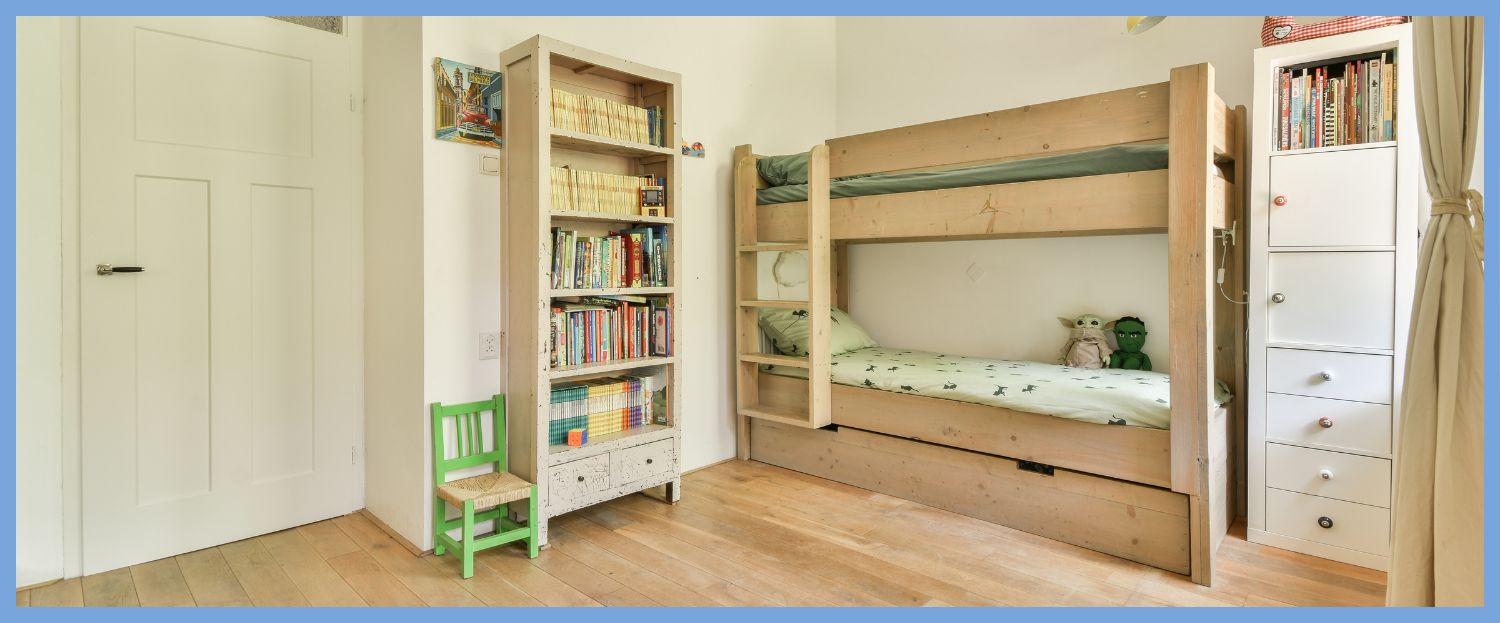Everything You Need to Know About Bunk Bed Safety
Bunk beds have long been a popular choice for families looking to save space in their children's bedrooms. They offer a practical solution for accommodating siblings or sleepovers while making the most of limited floor space. However, while these beds may be a fun and space-saving choice, it is essential to understand and implement bunk bed safety measures to keep your children safe and prevent accidents.
One of the primary concerns when it comes to bunk bed safety is ensuring that the child sleeping on the top bunk is secure from falling. This includes choosing a bunk bed with sturdy guardrails, appropriate mattress size, and a suitable age limit for occupants. Additionally, it is crucial to educate children on the correct way to use a ladder and discourage playing or jumping on the bunk bed to minimise the risk of injury.
Another vital aspect of bunk bed safety is regular maintenance and inspection. This involves checking the bed frame's stability, tightening loose bolts and screws, and assessing the structural integrity of the ladder and guardrails. By attending to these precautions and fostering a culture of safety awareness, parents can confidently provide their children with a fun and functional sleeping arrangement.

Understanding Bunk Bed Safety
The Importance of Bunk Bed Safety
Bunk bed safety is crucial, particularly when it comes to children's bedrooms. Bunk beds are a popular space-saving solution, but they also pose potential risks if not used safely. To ensure the wellbeing of your child, understanding and adhering to the recommended safety guidelines is essential.
The importance of bunk bed safety lies in preventing accidents such as falls, entrapment, and many other injuries. By taking appropriate precautions, you can create a safe and comfortable sleeping environment for your children.
Safety Guidelines Overview
- Age restrictions: Bunk bed usage is recommended for children aged six and above. The top bunk should be reserved for older children capable of climbing up and down the ladder safely.
- Railings: Ensure all sides of the top bunk have sturdy railings, with a gap of no more than 10 cm. This prevents the child from slipping through the rails or becoming trapped.
- Ladder: The ladder should be securely attached and in good condition. Teach children the proper use of the ladder and discourage climbing on the bed frame or using the bed as a play area.
- Mattress size: Use the correct mattress size indicated by the manufacturer to avoid gaps that may pose a hazard.
- Safety standards: Make sure the bunk bed complies with British Standards Institution (BSI) safety standards BS EN 747.
- Routine maintenance and checks: Regularly check the structural integrity of the bunk bed, ensuring that the frame, screws, and fastenings are secure.
- Room layout: Avoid positioning the bunk bed close to hazards such as windows, heaters, or hanging light fixtures.
By complying with these safety guidelines, parents can significantly reduce the risk associated with bunk bed usage. Always prioritise your children's safety and well-being, and encourage them to adopt safe habits while using bunk beds.
Selecting the Right Bunk Bed

Size and Quality Considerations
When choosing a bunk bed, it is essential to consider both the size and quality of the bed. The size should be appropriate for the space available in the room. Measure the area before purchasing and make sure there is enough room around the bunk bed for comfortable access.
- Size: Standard bunk beds are typically 90cm x 190cm. However, there are also small single, small double and European sizes available.
- Space: Leave a minimum clearance of 2 feet along the side of the bunk bed that has the ladder, and ensure there is enough headroom for the person using the top bunk.
Quality is equally important, as a well-constructed bunk bed provides stability and safety for its users. Look for bunk beds made from high-quality materials like solid wood or metal, with sturdy slats and secured connections. Check the manufacturer's guidelines for weight limits, and make sure the bunk bed conforms to the British Standard BS/EN7472012+A1 for safety and performance.
Related Post: A Guide to UK Bedroom Sizes
Appropriate Age and Weight Limits
Bunk beds are designed with age and weight limits in mind, and adhering to these guidelines is crucial for the safety of the users. Generally, bunk beds are recommended for children aged six years and older, though each product may have specific age requirements.
- Toddler safety: It is not safe for toddlers under the age of six to use bunk beds due to the risk of falls or entrapment.
- Adults: Some bunk beds may be suitable for adults, but it is essential to check the weight limits before using them.
|
Weight Limit |
Age Group |
Recommended Bunk Bed Type |
|
Up to 15st (95kg) |
6-18 years |
Standard children's bunk beds |
|
Up to 18st (114kg) |
Teenagers |
Heavy-duty bunk beds |
|
Up to 20st (127kg) |
Adults |
Adult bunk beds |
Always adhere to the manufacturer's specifications regarding weight restrictions. Regularly check the bunk bed for any signs of wear or damage, and make sure children understand the importance of using the bunk bed safely.
Key Safety Features

Safety Rails and Guardrails
One of the most critical safety features in bunk beds are the safety rails and guardrails. They should be installed on all sides of the upper bunk, with a minimum height of 5 inches (13 cm) above the mattress surface. This helps prevent accidents by ensuring the child doesn't roll out of bed during their sleep. It's important to inspect the rails regularly for any damages or faulty installations.
Sturdy Ladders and Treads
Access to the upper bunk should be secure and reliable. A sturdy ladder made of robust materials is essential. Ladders should be firmly attached to the bunk bed frame, with no wobbling or looseness. Additionally, the ladder's steps or treads should have a slip-resistant surface or feature grooves to increase traction, greatly reducing the risk of slips and falls.
Appropriate Mattress Fit and Guard Rail Gaps
Choosing the right mattress for a bunk bed is crucial for both comfort and safety. The mattress should fit snugly within the frame, with no more than a 1-inch (2.5 cm) gap on all sides. This minimises the possibility of entrapment between the mattress and the bed frame.
Guard rail gaps should also be considered. The distance between the guardrails or safety rails should not exceed 3.5 inches (9 cm) to prevent children from getting their heads or limbs stuck, as specified by British standards.
In summary, when selecting a bunk bed, ensure it's equipped with proper safety rails, a sturdy ladder, and the appropriate mattress. Regularly inspect and maintain these safety features to provide a secure and comfortable sleeping environment for children.
Safe Usage Guidelines
Rules for Safe Sleep and Play
It is essential to ensure the safety of children while they sleep and play on bunk beds. Consider the following recommendations for a secure and enjoyable experience:
- Age restriction: Children under six years old should not sleep on the top bunk, as they may lack the physical coordination and judgement necessary for safe use.
- Guardrails: Ensure that guardrails are installed on both sides of the top bunk to minimise the risk of falls. Check their stability regularly.
- Mattress size: Select a mattress that fits snugly within the bed frame, preventing gaps that could pose an entrapment hazard.
- Weight capacity: Be mindful of the manufacturer's recommended weight limits for the top and bottom bunks. Overloading may compromise the bed's structural integrity.
- Toys and items: Keep the top bunk clutter-free to reduce the risk of objects falling onto the lower bunk.
By following these suggestions, a bunk bed can provide a fun and adventurous environment for children while also maintaining their safety.
Bunk Bed Access and Ladder Safety
In addition to safe sleep and play practices, it is crucial to consider the bunk bed's access points, particularly the ladder. The following guidelines can help ensure proper usage and safety:
- Ladder positioning: Choose a bunk bed with a ladder that is either securely attached to the bed frame or positioned at a safe angle, preventing slipping or tipping over.
- Climbing instructions: Teach children to always use both hands while climbing up or down the ladder, and discourage horseplay.
- Footwear: Ensure children wear nonslip socks or go barefoot when using the ladder to avoid slipping.
- Ladder maintenance: Regularly inspect the ladder and bed frame for loose connections, and promptly tighten or replace any damaged parts.
By adhering to these precautions, parents and guardians can confidently allow their children to enjoy their bunk bed adventures while minimising safety risks.
Installation and Maintenance

Correct Assembly and Installation
Proper bunk bed assembly is crucial for ensuring the safety of its occupants. Carefully follow the assembly instructions provided by the manufacturer. If the instructions are unclear or missing, consult the manufacturer's website or contact their customer service for assistance.
- Assemble the bunk bed on a flat, stable surface to prevent any wobbling
- Ensure all screws, bolts, and fastenings are tightened securely
- Use only the hardware provided by the manufacturer, as they have been specifically designed for the bed's stability and safety
- Check for any sharp edges, protruding objects, or potential hazards that could harm the user
Regular Safety Inspections and Maintenance
Conduct routine inspections and maintenance to keep your bunk bed secure and in optimal condition:
- Monthly visual checks:
- Inspect for any damage or wear, paying special attention to the connectors and joints
- Test the ladder's stability and attachment
- Check for any loose, broken, or missing slats
- Examine for signs of rust or corrosion on metal parts
- Six-monthly tightening of fastenings:
- Ensure all screws, bolts, and other fastenings are still tightly secured
- Annual comprehensive inspection:
- Disassemble the main components if necessary and conduct a thorough examination for hidden signs of wear or damage
Regular maintenance should include:
- Wiping down all surfaces with a damp cloth, avoiding excess water that may damage the material
- Using a vacuum cleaner to remove dust and dirt from under the bed and in crevices
- For wooden bunk beds, consider applying wood treatment or varnish as needed to protect the material
Note: Always consult your bunk bed's specific care instructions and guidelines provided by the manufacturer. Regular maintenance not only prolongs the lifespan of the bed but also ensures safety for its users.
Legal and Regulatory Considerations
UK Safety Regulations and Standards
When choosing a bunk bed in the UK, it is essential to be aware of the relevant safety regulations and standards. The British Safety Standard BS/EN7472012+A1 provides guidelines that manufacturers must follow to ensure their bunk beds are safe for use by children. It covers various aspects of safety, including:
- Stability: Bunk beds must be stable and robust, with a sturdy frame that can support the weight of the occupants without collapsing or swaying.
- Guardrails: To prevent falls, guardrails should be installed on both sides of the upper bed. The minimum height for guardrails is 16cm above the mattress surface. Gaps between the guardrail and the frame must not exceed 7.5cm.
- Access: Bunk beds must have a secure and robust ladder or other means of access to the upper bed. The ladder's rungs should be spaced evenly, no greater than 30cm apart, and fixed to the bed frame or floor for added stability.
- Mattress support: The slats or mesh supporting the mattress must be strong and adequately spaced to prevent the entrapment of limbs or the mattress from sagging.
It is crucial to select a bunk bed that conforms to the British Safety Standard BS/EN7472012+A1, as this will ensure it meets the basic safety requirements.
Manufacturer's Guidelines and Warranties
In addition to complying with the UK safety regulations and standards, it is essential to familiarise oneself with the manufacturer's guidelines. These guidelines often provide valuable details on installation, usage, and maintenance that are specific to the bunk bed model you have chosen.
Be sure to examine the following aspects:
- Assembly instructions: Carefully read and follow the instructions provided by the manufacturer to ensure the bunk bed is assembled correctly and securely. Incorrect assembly may compromise the bed's safety and stability.
- Weight limits: Most manufacturers stipulate weight limits for their bunk beds. Adhering to these limits is vital as exceeding them may cause the bed to collapse or become unstable, posing a safety risk.
- Age restrictions: Manufacturers typically provide a minimum age recommendation for children using the upper bed, usually around six years old. It is crucial to abide by this safety guideline to minimise the risk of injury.
- Safety precautions: Some manufacturers provide additional safety precautions or warnings, such as ensuring that children do not jump on the bed, play roughly around it, or hang items on the rails.
- Warranties: Ensure you are aware of the bed's warranty and its terms, which usually cover defects in materials and workmanship. Keep all documentation in case you need to lodge a warranty claim in the future.
By following the UK safety regulations, British Safety Standards, and the manufacturer's guidelines, you can select and maintain a bunk bed that offers a safe and comfortable sleeping environment for your children.
Addressing Common Safety Concerns

Preventing Accidents and Injuries
One of the primary concerns with bunk beds is the potential for accidents and injuries. To mitigate risks and promote safety, consider the following guidelines:
- Age restriction: Children under six years old should not sleep on the top bunk, as they are at a greater risk of falling.
- Guardrails: Ensure that the top bunk has guardrails on all four sides and that they are securely fastened. Gaps between the mattress and the guardrails must be minimal to prevent entrapment.
- Climbing access: Ladders or stairs should be installed firmly and positioned at a suitable angle for easy access to the top bunk.
- Weight limit: Adhere to the manufacturer's guidelines regarding weight limits for both the top and bottom bunks.
- Foundation support: Regularly check the bunk bed's frame and mattress support system for any signs of wear or damage to ensure stability.
- Proper positioning: Position the bunk bed in a corner of the room, with walls on two sides, to enhance stability and reduce the chance of a fall.
Design Flaws and Recalls
When purchasing a bunk bed, it is crucial to be aware of potential design flaws and recalls to ensure safety. Take the following precautions:
- Research: Investigate the manufacturer's reputation and check for any reported safety issues or recalls associated with their products.
- Compliance: Opt for bunk beds that comply with British Standards (BS/EN7472012+A1), demonstrating that they meet safety requirements.
- Safety features: Look for beds with additional safety features, such as anti-entrapment openings and secure fastening systems for guardrails and ladders.
- Assembly: Follow the assembly instructions meticulously to avoid any mistakes that could compromise the bunk bed's stability.
By considering these factors, parents and guardians can take a proactive approach in minimising risks and promoting safety when choosing and maintaining bunk beds.
Alternative Sleeping Solutions
When to Choose a Normal Bed Over a Bunk Bed
While bunk beds can be an excellent space-saving solution for children's bedrooms, there are times when it is more suitable to opt for a normal bed. Firstly, if safety is a primary concern, a normal bed inherently poses fewer risks compared to a bunk bed, as there is no risk of falling from height. Additionally, when children are particularly young or have difficulty with motor skills, a normal bed is a safer option.
Another reason to consider a normal bed is if detachable furniture will be used frequently in the bedroom. Bunk beds, while compact, can make it more challenging to rearrange the room or accommodate additional furniture (such as bedside tables), whereas normal beds provide flexibility in layout.
Space-Saving Ideas Beyond Bunk Beds
Even without using bunk beds, there are several other space-saving ideas that can be applied to children's bedrooms. Here are some alternative options:
- Cot Beds: For very young children, a cot bed is a handy solution. These beds easily convert from a cot to a toddler-sized bed, ensuring the bed remains appropriate for the child's size and age without consuming too much space.
- Trundle Beds: A trundle bed includes a hidden extra bed underneath it, which can be pulled out when needed. This is ideal if you have two children sharing a room or if your child has friends over for a sleepover, as it maximises available floor space during the day.
- Multifunctional Furniture: Invest in furniture that serves double-duty, such as desks that convert into beds or storage units that incorporate beds. This reduces the quantity of furniture required in the room while still fulfilling multiple needs.
- Built-In Storage: Make the most of your wall space by installing built-in storage solutions, such as shelves, cupboards, and wardrobes. This eliminates the need for bulky free-standing furniture, creating more space in the room for play or other activities.
By considering these alternative sleeping solutions and space-saving options, it is possible to create a safe, comfortable, and functional environment in children's bedrooms without relying solely on bunk beds.




